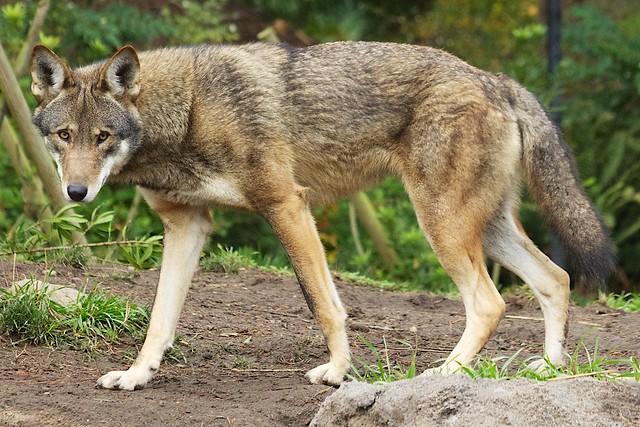Diet
Red wolves are known to hunt individually and in packs, eating white-tailed deer, raccoons and small mammals such as rabbits and rodents. They have also been known to prey on domestic pets and livestock, but in very small numbers.
Breeding and Maturation
Similar to gray wolves, red wolves live in the social structure of a pack, with a defended territory, an adult breeding pair and older offspring that assist with pup rearing.
Hybridization Issue
Scientific studies disagree over whether the red wolf is indeed a separate species, a subspecies of the gray wolf, or hybrid between gray wolves and coyotes. However, based on available research, the U.S. Fish and Wildlife Service have legally designated the red wolf, Canis rufus, a distinct species. Thus far, petitions to delist the red wolf on grounds that it is a hybrid have been defeated, and Canis rufus remains a protected species under federal law in the United States.
To further complicate the issue, work on wolves in Algonquin Provincial Park, Canada suggests that wolves there are closely related to the red wolf. Researchers working in the park argue that the red wolf and eastern timber wolf should be joined as a species, separate from the gray wolf. The debate is likely to continue for some time.
Conservation
The red wolf recovery project in the eastern United States has differed from gray wolf reintroduction projects in the western states. Unlike gray wolves, red wolves faced an imminent threat of extinction. By 1920, the red wolf had been extirpated in most of the southern states, and by 1970 less than 100 red wolves remained in the entire United States, confined to a small area of coastal Texas and Louisiana. Early bounties and indiscriminate killing caused the rapid decline of red wolf numbers. Loss of habitat perpetuated this decline in the mid 1900's as people cleared land for roads, livestock, agriculture, logging and mining.
Red wolf recovery initially focused on preserving and expanding the remaining wild red wolf population. However, as red wolf numbers spiraled downward, coyote populations expanded eastward and established a foothold in areas that had been dominated by wolves. When the few remaining red wolves failed to find mates of their own species, many mated with coyotes. As this hybridization increased, the number of genetically pure red wolves decreased, further accelerating the decline of the red wolf. As a result, recovery efforts shifted in focus to capturing red wolves and proving their genetic purity, and then breeding them in captivity with a goal of future reintroduction. By 1980 the last red wolf was captured, and the species was declared extinct in the wild.
With successful breeding, captive animals were first released in the Alligator River National Wildlife Refuge (ARNWR) in northeastern North Carolina in 1987. This was an ideal site for reintroduction because it is surrounded on three sides by large bodies of water and holds low densities of humans, livestock and coyotes. Within their first year, the wolves successfully produced their first litter of pups in the wild. By 1993 captive red wolves had also been successfully released in the Pocosin Lakes National Wildlife Refuge in North Carolina and Great Smoky Mountains National Park in Tennessee, and on three island propagation sites off the Atlantic and Gulf Coasts.
Reintroduction in northeastern North Carolina has been a success, with a current population of about 100 free-ranging wolves. Efforts in the Great Smoky Mountains, however, were less successful. Low to almost non-existent pup survival prevented the released wolves from establishing and expanding home ranges and developing family groups with the park's boundaries. Biologists suspect disease, predation, malnutrition, and parasites as contributing factors to the low success. There were also human-wolf conflict issues due to bordering livestock operations and depredation of a few calves on a lease operation within the park. In October of 1998, the U.S. Fish and Wildlife Service and the National Park Service announce plans to recapture all red wolves that remained in the park and to relocate them to northeastern North Carolina, ending efforts to restore red wolves in the Great Smoky Mountains. Horn Island was also removed from the island propagation program that same year because of increasing probability of wolf interactions with humans.
Today, due to an aggressive preservation effort mandated by the Endangered Species Act, red wolf numbers are slowly rising, and the wolves again roam through parts of their historic range in eastern North America. The future of the red wolf is not yet secure. More than half of the population exists in captivity, and efforts to reintroduce them continually face challenges. Captive breeding continues to preserve genetically pure red wolves and the red wolf Species Survival Plan (SSP) recovery goal is to maintain 330 genetically pure wolves in captivity and 220 wolves in the wild, within at least three self-sustaining population.

